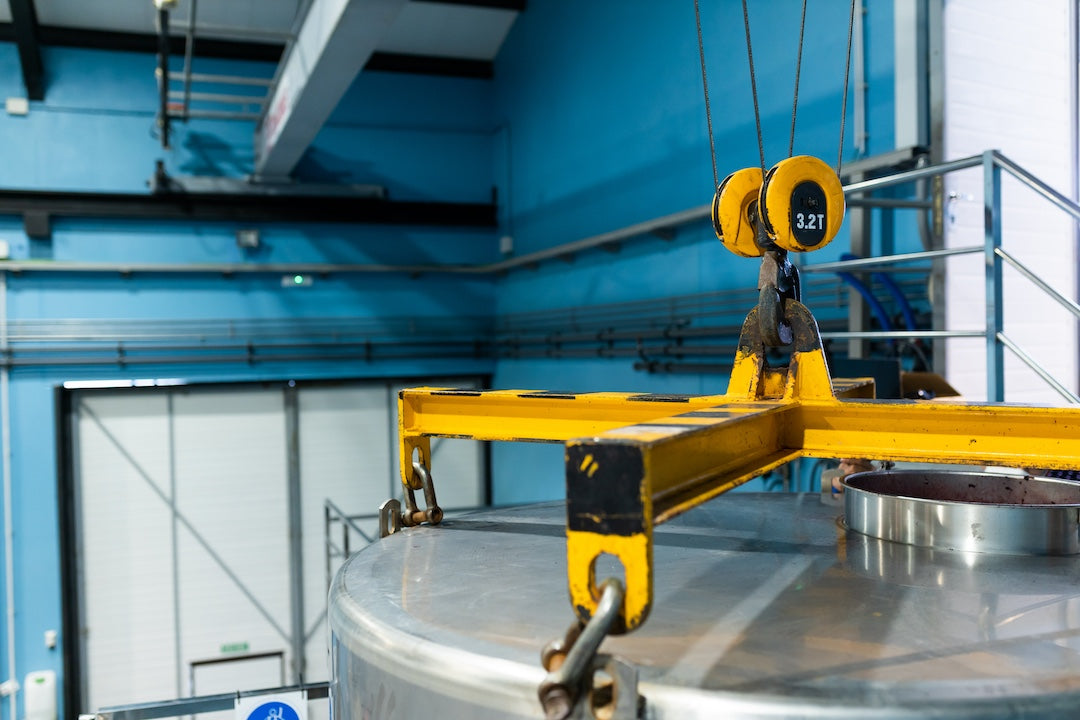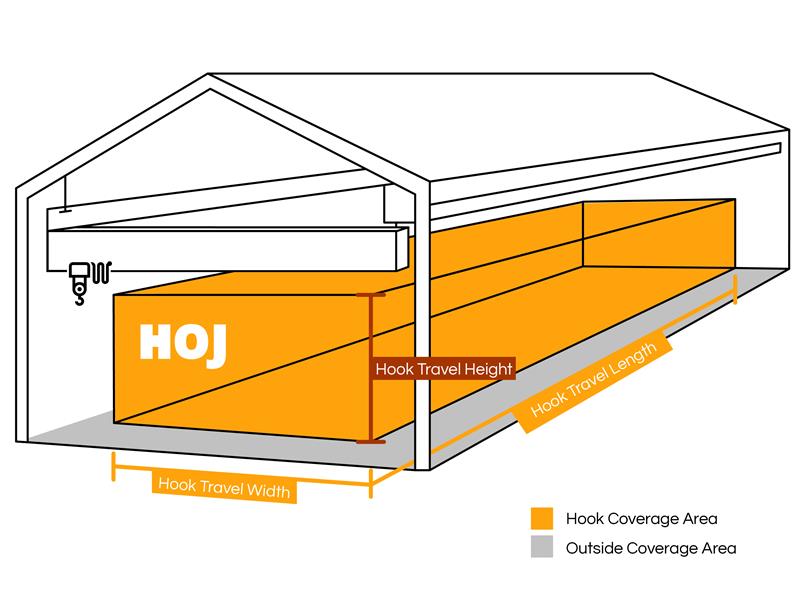Your Cart is Empty

Forklift Guide For Small Business - The Warehouse Floor Ep. 2
In this episode of “The Warehouse Floor,” we are joined by our forklift expert, Ken Keeran, who brings two decades of experience and knowledge in the forklift industry.
Ken is being interviewed by Nick Wills, One of Hoj Innovations' top customer service reps.
Their detailed discussion on various aspects of forklifts offers valuable insights for business leaders looking to optimize their warehouse operations.
Throughout this episode, Ken discusses when to consider purchasing a forklift, the different types of forklifts available, how to choose the right one for your specific needs, and other essential factors to consider before buying your own.
This article distills the podcast episode into an educational guide aimed at helping you make the most informed decisions possible before purchasing a forklift.
Table Of Contents
- When to Consider Buying a Forklift
- Specialized Forklifts And Pallet Jacks
- Strategic Forklift Selection for Optimal Operations
- Matching Forklifts To Racking Systems
- Common Concerns and Key Comparisons
- Wire Guidance Systems V.S. Rail Guidance Systems
- Forklift Costs and Redundancies
- The Importance of Tailored Solutions
When to Consider Buying a Forklift
Many new operations and small businesses don’t own a forklift. Instead, they rent from local shops on a need-by-need basis.
Determining the right time to purchase a forklift can be stressful and is a pivotal decision for any business engaged in warehousing or logistics.
Ken Keeran broke this down into one simple question. Are you moving pallets daily? If you are, and you typically need a forklift to do this, then it is time to purchase your own lift.
Once truckloads start coming in regularly, it becomes essential to consider financing or purchasing a forklift, as renting or borrowing equipment can become more expensive than owning over time.
By owning a forklift, businesses reduce overall expenses and enhance efficiency, as the equipment is readily available whenever needed, ensuring that operational demands are met consistently.
Specialized Forklifts And Pallet Jacks

As storage density in a warehouse increases, pallet racking rows tend to get narrower. As this occurs, it becomes too dangerous or even impossible for standard forklift options to fit; this is where specialized forklifts come into play.
Each specialized option offers unique advantages for handling specific warehouse challenges; specialized forklifts include Reach Trucks, Flexi Forklifts, and Turret Trucks.
Additionally, electric pallet jacks offer greater flexibility, increased movement speed, and an incredible set of benefits worth considering.
Understanding what options you have available to you is critical to maximizing your warehouse’s potential.
Different Forklift Classes and Aisle Considerations
Ken states that narrow pallet racking aisles start at 10-½ feet wide, where “a traditional sit-down forklift won’t fit.”
He continues, “When going narrow aisle, it’s crucial to talk to your forklift and systems guy to ensure the forklift and racking system work together.”
Many forklifts are designed to solve specific warehousing problems. So, it proves necessary to match the right forklift for the particular issues you and your business are facing.
The design of the racking system should consider the dimensions and operational characteristics of the forklift to maximize efficiency and safety.
Here are three narrow aisle forklift types to consider. Reach Trucks, Forward Articulating Forklifts (Flexi), and Turret Trucks.
Reach Trucks

Reach trucks have a more streamlined frame when compared with a standard forklift and come in sit-down and standup versions.
These are electrically powered and can operate in aisles between 9’ and 10 1/2’ wide. They are equipped with outer legs to help distribute the pallet weight and keep the lift from tipping over.
These are very easy to control and maneuvered into tight aisle spaces.
The Flexi Forklift

Flex Forklifts, also known as forward articulating forklifts, are large forklifts with a unique feature. The front head can swivel left and right. Due to this ability to move the front forks left and right without turning the entire forklift, it can operate in extremely narrow aisles that are just 6’ to 8’ wide.
The Flexi can even put pallets away at right angles. It can operate inside and outside as long as it is on smooth surfaces, making this an incredibly versatile lift and an excellent choice for many growing brands.
However, the Flexi is more expensive than forklifts dedicated solely to indoor or outdoor use.
For companies with a mix of tasks spanning both environments, its operational efficiency can justify the investment in a Flexi forklift.
Turret Trucks

Turret Trucks are for companies that need to go even narrower than 6’. These are for companies that want to maximize their total storage space.
It is essential to note that maximizing storage density typically comes at the cost of picking speed. So, lower throughput times can be expected.
While moving down an aisle, a Turret Truck can grab pallets on the left or right without turning the truck. As the forks lift to the desired height, so does the operator, which allows them to properly align the forks with each pallet and avoid damaging the storage shelves.
Your pallet sizes must fit from 40” to 48”; otherwise, you cannot pick them up as the forks are set to a fixed width.
Walkie Pallet Jacks and Rider Pallet Jacks

Electric pallet jacks are often overlooked but are integral in most large warehousing operations. There are two kinds to be aware of. The Walkie Pallet Jack and the Rider Pallet Jack are both electric options and great for moving pallets over varying distances.
The walkie-pallet jack - as the name suggests - you walk behind, but it is electrically powered for lifting and moving heavy inventory pallets. It is a compact machine perfect for quick tasks across small areas. “Not everyone can pump up a jack with 6,000 lbs on it. An electric jack can handle that.” - Ken.
On the other hand, the rider pallet jack is a more robust option, equipped with a platform for the operator to ride on, making it suitable for moving pallets over longer distances.
Both options are cost-effective and efficient, with the choice between them depending on the specific needs of your warehouse.
Task Support Vehicles

Task support vehicles, commonly called pickers, represent a unique warehouse equipment category, bridging the gap between traditional forklifts and other material handling tools.
Ken describes, “These are not forklifts but task support vehicles like the Big Joe J-1 192.” These vehicle types lift people, not pallets.
They allow you to extend pick-faces upwards of 15 feet or more. These are great for “individual boxes or smaller products. That’s what it’s designed [for]” - Ken Keeran
These are ideal for micro-fulfillment centers such as e-commerce, apparel, and similar brands, offering a safer, more efficient alternative to rolling ladders.
They’re also more user-friendly, requiring less training and no special certification to operate.
Coming in at roughly a quarter the cost of a traditional forklift, these are affordable, safe, and effective.
Strategic Forklift Selection for Optimal Operations
Most new business leaders with warehouses never expected that there would be a strategy associated with forklift selection. While rarely expected, it is essential for getting the most out of your storage facility.
From choosing between electric and diesel models to adopting a mixed fleet, each decision impacts efficiency and long-term costs. With a shift toward electric forklifts and high-density storage solutions, weighing the benefits of established brands and tailored equipment for specific tasks is crucial.
Forklift Capacities and Application

It is a common belief that diesel-powered forklifts have the highest lifting capacity. Ken explained that this is a myth.
Lithium-ion battery-powered forklifts can match the lifting capacity of diesel-powered forklifts but with one major drawback. As capacity increases, “It becomes cost-prohibitive” to keep choosing electric.
For example, diesel-powered forklifts are generally more cost-effective when handling lifting capacities above 20,000 pounds. Also, diesel forklifts are more accessible to service and maintain when handling heavy loads, particularly outdoors.
The Importance of Mixed Fleets

A mixed fleet approach to forklift management is increasingly common among growing businesses. Once you grow to a specific size, fielding a more diverse selection of pallet movers makes more sense.
Rather than relying on a single type of forklift for all tasks, companies are investing in a variety of equipment tailored to specific functions within the warehouse. “most companies use a mix of equipment tailored to different tasks, such as reach trucks for storage and sit-down lifts for shipping and receiving.” - Ken.
For example, an enormous warehouse might want I.C. forklifts to assist with unloading and loading delivery trucks and Reach trucks to store the pallets in their high-density storage rack with narrow aisles. In addition, they might have electric Rider Pallet jacks to facilitate the fast transportation and organization of pallets on the floor. Lastly, having a task support vehicle to operate in their 15-foot pick face helps maximize their warehousing potential.
This mixed fleet approach allows businesses to fine-tune their operations, ensuring that each piece of equipment is used efficiently and cost-effectively.
What Are The Most Common Forklifts Sold?
In 2024, Utah’s most commonly sold forklifts continue to be sit-down internal combustion (I.C.) engine lifts.
With that said, Ken Keeran noted a dramatic shift in the market towards electric forklifts, particularly reach trucks. Believe it or not, environmental concerns and real estate prices have primarily driven this change.
As property prices have increased, companies are looking to build pallet racking systems as high as possible for as cheaply as possible. Electric turret trucks meet this need ideally, as they have exceptionally high-density storage capabilities, especially compared to I.C. forklifts.
Should I Purchase From a New Forklift Brand?
In a market where new forklift brands are constantly emerging, opting for cheaper, less-established options can be tempting. However, going with newer, untested brands is risky and not advisable.
Reliability is crucial in warehousing, especially when it comes to forklifts. Businesses depend on their forklifts daily and usually cannot afford a lift to break down for hours, days, or even weeks in some cases.
This is where established brands and dealerships offer significant advantages over cheaper, newer brands.
The benefits established brands have over newer brands are as follows.
- Readily available with quality parts
- Better warranties
- Established reputations for reliability and quality.
- Trained & experienced service teams for quick, affordable repairs
- Backed by extensive dealership networks that provide quick and prompt service nationwide.
A partnership with a local dealer is essential for minimizing downtime.
In contrast, newer forklift brands may need more support than their established counterparts, leading to more repairs, extended downtimes, and potentially higher long-term costs.
Matching Forklifts To Racking Systems
Double Deep Reach Truck Systems: Pros and Cons
Sometimes, it makes sense to go two rows deep with your pallet racking to increase storage density further. Standard fork trucks cannot reach two rows deep; double-deep reach trucks were developed to solve this issue.
Double-deep reach truck systems allow two pallets to be stored twice as deep in a single aisle.
According to Ken Keeran, these systems come with inevitable trade-offs: first is, you now have a pantograph system, which means that the forks on the front of the forklift extend out from the mast -with a scissor lift type mechanism- twice as far as they would on a standard forklift resulting in lower capacity limits on this type of vehicle.
Extending your forks twice as far out past the forklift’s center of mass means your forklift will have to be heavier and, thus, larger to account for that extra load.
This added capability is more expensive to maintain and requires a skilled and attentive operator to precisely control the extended arm to avoid damaging pallets or racks. It is a difficult job as it involves reaching the forks twice as far as usual.
Ken Keeran explained that a “double-deep reach is a good option. Again, if you don’t have crazy throughput, meaning you’re not putting away tons and tons of pallets, and you want the [increased] storage density.” If you have a high throughput of inventory, this is most likely a storage method you’ll want to pass on, as increased storage density reduces the speed at which you can access your inventory.
While these systems can significantly boost storage capacity, they are best suited for environments with moderate throughput, and the storage needs justify the added complexity.
Discussing your needs with an inventory forklift like Ken Keeran is one of the best ways to ensure you save money.
Common Concerns and Key Comparisons
Understanding the differences between battery types, tire options, and the suitability of electric forklifts for outdoor use can help you make the best choice for your warehouse’s needs and goals.
Internal Combustion Forklifts vs. Electric Forklifts

Choosing between an internal combustion (I.C.) forklift and an electric forklift requires careful consideration of your industry’s specific needs and the operating environment.
Ken Keeran points out that “in the industry, you need to consider whether there are any requirements that prohibit Internal Combustion (I.C.) engines,” especially in sectors like food processing, where electric forklifts are required to prevent dirty emissions.
Electric forklifts are also ideal for other clean operation environments, such as pharmaceutical or high-tech manufacturing facilities.
On the other hand, I.C. forklifts, which run on fuels like LP propane or diesel, are better suited for large outdoor use and rough terrain.
Electric Forklifts: Lead Acid Batteries vs. Lithium-Ion
When it comes to electric forklifts, the choice between lead-acid batteries and lithium-ion batteries is significant.
Ken Keeran highlights that while “lead-acid batteries are well-known,” they have been used in the industry for decades. Lithium-ion batteries “show great promise” despite being a relatively new technology and more expensive.
Lithium-ion batteries offer higher energy density, faster charging times, and longer lifespan than their lead-acid counterparts, making them an attractive option for businesses.
The decision between the two is based on your specific operational needs and budget considerations.
Can You Operate the Electric Forklift Outside?
Modern electric forklifts have advanced significantly, making them suitable for indoor and outdoor use, even in challenging weather conditions. Ken Keeran confirms that “modern electric lifts can be used outdoors, even in rain and snow, with proper precautions.”
When considering an electric forklift for outdoor operations, selecting the correct type of tires—cushion or pneumatic—is essential based on the surface conditions.
Electric forklifts with optional features such as cabs, heaters, and air conditioning enhance operator comfort and safety in adverse weather. These advancements make electric forklifts a viable option for companies looking to reduce emissions and energy costs without sacrificing performance in outdoor environments.
Cushion Tire vs. Pneumatic Tire Forklifts

The choice between cushion tire and pneumatic tire forklifts is often dictated by the width of your aisles and the nature of your working environment.
Cushion tire forklifts are designed for indoor use and work best in smooth, flat environments. Their smaller chassis allows them to operate in tighter spaces, such as aisles as narrow as 12 feet.
Cushion tires can be ordered with and without tread and are for warehouse floors or outside if the cement or asphalt is smooth and well-maintained.
Pneumatic tire forklifts are built to handle rougher outdoor environments and require wider aisles—typically around 13-½ to 14 feet—due to their larger size. These forklifts are more versatile in terrain but may not be the best choice for operations requiring high storage density in narrow aisles.
Pneumatic tires are better for outdoor use, and Cushioned tires are more appropriate for indoor use.
Wire Guidance Systems V.S. Rail Guidance Systems
Pallet racking can support hundreds of thousands of pounds throughout a warehouse when under load. They are specifically engineered to hold that weight. They are not designed to take a hit from a 3-ton forklift.
Accidents happen, and wire and rail guidance systems were designed to prevent accidents like this, especially in narrow-racking systems, where it becomes harder to navigate large machinery.
A wire guidance system involves embedding a wire in the floor that emits a radio signal picked up by the fork truck, keeping it aligned between the pallet racking aisles.
Alternatively, rail guidance uses physical rails to guide the forklift, similar to how a roller coaster operates.
Wire guidance is practical, cost-efficient, and much easier to install than rail guidance systems.
Ken Keeran says, “Wire guidance is less expensive on the steel side when planning these rack systems.”
In addition to the added cost, rail guidance has another downside. Due to physical rail(s) running down the aisles, forklifts cannot access the ground-level pallets, while wire guidance can.
According to Nick Wills, this extra space on the bottom can even impact the “overall seismic rating of that rack and decreases the potential weight capacity” of your pallet rack.
This means that wire guidance can contribute to savings not just on the forklift side but also on the structural side of the warehouse.
Nick Wills elaborated, “The greatest thing that I love about wire guidance is rack safety,” emphasizing that wire guidance enhances rack safety by reducing the risk of collisions, which is crucial in high-density storage environments.
Whichever system you choose, it will help prevent turning errors, reduce the risk of collisions with racks, and improve overall safety.
Forklift Costs and Redundancies
There are two essential aspects of forklift operations: the costs associated with ownership (including maintenance and TCO) and the importance of redundancy planning, especially for specialized equipment.
Forklift Maintenance and Total Cost of Ownership

When choosing between an I.C. forklift and an electric forklift, one of the key considerations is the total cost of ownership (TCO).
Ken Keeran explains that I.C. forklifts typically have a lower upfront cost but tend to incur higher maintenance expenses over the lifetime due to engine complexity and fuel cost. He notes that “an I.C. internal combustion engine forklift...is going to be more expensive maintenance-wise throughout its life.”
In contrast, electric forklifts have fewer moving parts, leading to lower maintenance costs and less downtime. Electric forklifts are quieter and provide instant torque, offering a more responsive and efficient operation.
Electric forklifts may offer long-term savings in maintenance but have higher upfront costs, especially for lithium-ion batteries.
Despite these benefits, it is essential to factor in the cost of replacing batteries, particularly for electric forklifts using lithium-ion technology, which can be a significant investment. Lithium-ion batteries are usually between 4 and 5 times more expensive to replace than their lead-acid counterparts.
Redundancy and Planning for Specialized Equipment
Redundancy is critical for any warehouse operation.
“For highly specialized systems like turret trucks in tall buildings, having redundancy is critical to avoid operational downtime if equipment fails.”
These forklifts are often custom-built for specific applications, making them difficult to replace or repair quickly if they fail. Without a backup, a single equipment failure can bring operations to a standstill, leading to significant financial losses.
Businesses should invest in redundant equipment or have a plan in place for rapid repair or replacement to mitigate this risk. This might involve keeping an additional turret truck on hand or ensuring a service provider can quickly supply a rental unit in an emergency.
Planning for redundancy is essential when downtime is not an option and the equipment is integral to the business’s day-to-day operations.
The Importance of Tailored Solutions
In the ever-evolving world of warehouse operations, selecting the right forklift and storage solutions requires more than just picking the latest or most powerful equipment.
It demands a tailored approach that considers the specific needs of your business, the nature of your inventory, and the unique challenges of your operational environment.
Ken Keeran underscores the value of an educated approach, stating that “it’s important to have conversations with experts when considering forklifts and storage solutions.”
Businesses can develop educated solutions that optimize efficiency, enhance safety, and drive success by engaging with experts who understand the equipment and the broader logistics landscape.
Whether choosing between different types of forklifts, planning for redundancy, or deciding on the best use of warehouse space, a well-informed decision-making process is vital to maintaining a competitive edge in today’s market.








